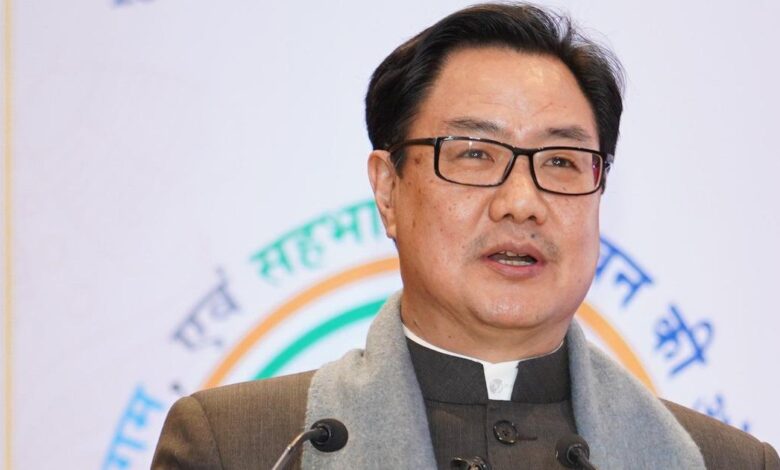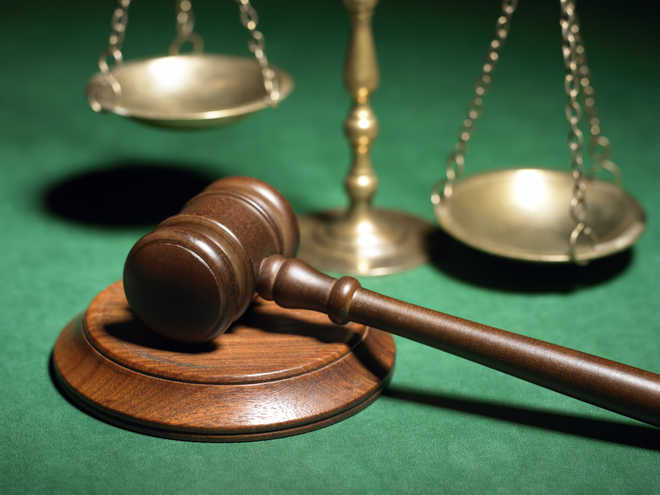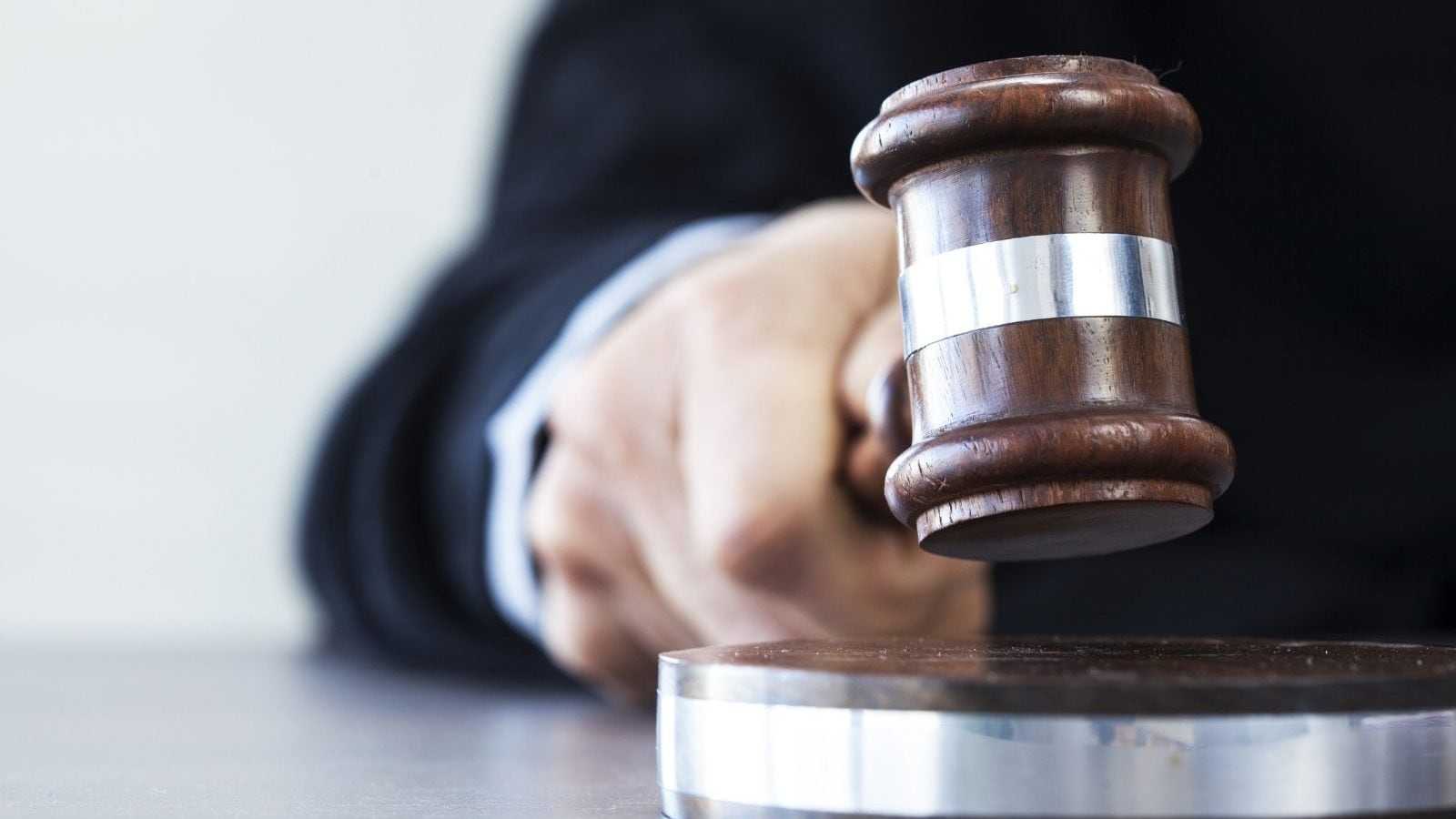Five crore lawsuits are pending in Indian courts, according to Law Minister Kiren Rijiju.

The number of court cases that are still waiting nationwide, according to Union Law Minister Kiren Rijiju, is “inching towards five crores” and has been a “cause of great worry.” While the number of cases pending in the Supreme Court and High Courts is probably going to decrease, Mr. Rijiju claimed that the “true problem” was in the subordinate courts. The lower court’s infrastructure, according to the law minister, must be improved through cooperation between the federal and state governments.
The Law Minister was addressing the ‘S Block’ opening ceremony for the Delhi High Court. Chief Justice of India (CJI) D.Y. Chandrachud, Judge Sanjay Kishan Kaul of the Supreme Court, Chief Justice of the Delhi High Court Satish Chandra Sharma, and other High Court justices also attended the ceremony.
“The Delhi High Court is itself a breath of fresh air in the halls of law. Even in the most trying of circumstances, it is a court of equity and a court of relief for citizens, according to CJI Chandrachud. The Chief Justice of India (CJI) Chandrachud emphasized that the legal system and courtrooms must be democratic, inclusive, and equally accessible, stressing that its layout must allow for individuals from various backgrounds to participate meaningfully.
Making sure we have an appropriate court infrastructure, including physical and digital infrastructure and staff strength, is crucial for realizing the right to access justice, he continued.
He declared, “We must develop a variety of equitable ways for various groups — women, Dalits, the marginalized community, the LGBTQ+ community, people with disabilities, the elderly, and the poor — to engage and participate in the adjudication process in a meaningful way.” According to CJI Chandrachud, the “S” block building would house more than 200 legal firms, a judicial convention center, an auditorium, a location for the Delhi International Arbitration Centre, administrative offices and parking spaces, common meeting rooms, a canteen, and green areas.
Why is there such a large case backlog in Indian courts?
The first explanation is not very harmful. However, it has contributed to the large backlog of cases. As a result of recent socioeconomic developments and a better grasp of their legal rights, more people are turning to the judicial system for justice. Judicial activism is one of the most effective techniques for safeguarding citizens’ rights. It is critical to implement social policies on topics such as individual rights, civil rights, public morality, and so on. As a consequence of the active judiciary’s embrace of new instruments like the PIL, more cases were filed.
The lack of sufficient judges is another major factor (only around 21,000). 10 judges per million people are the current judge-to-population ratio. At least 50 to 1 million are suggested by the Law Commission study from 1987. Since 1987, the population has grown by more than 25 crores. Problematic is that the States argue that the Center should take the lead in raising the number of judges, while the Center insists that the States do so. Additionally, there aren’t enough judges, and those that are assigned to the bench are often absent, particularly in the high courts.
Similarly to this, there are not enough courts in India due to a lack of resources in the judiciary. The judiciary is not a priority for the Center or the States. The budget for the Indian judiciary is only allocated between 0.1% and 0.4%. As a result, not all courts have been modernized and computerized. In India, the government is the main plaintiff in court and is involved in around half of all active lawsuits. Sometimes a government agency sues another, allowing the courts to make the judgment. Additionally, it is frequently observed that the government’s side of a case fails to provide sufficient evidence to support its claims.
The Indian legal system has had a difficult time attracting the best brains and most talented students. Due to bad judgments or unsatisfactory judges in lesser courts, appeals are filed in higher courts, adding to the total case burden. The specific source of this unhappiness is the judges’ lack of specialization or laziness.
Long-running legal conflicts can also be created by out-of-date legislation in the statute books, poor or confusing drafting, and differing court interpretations of those laws. Many of these laws were enacted for the first time in the 1880s. Even now, if someone wants to do something, they are provided with prior-century regulations and told to stop.
According to Law Minister Kiren Rijiju, the judiciary would soon go paperless.
On Tuesday, Kiren Rijiju, the union minister for law and justice, predicted that the Indian judiciary will soon be paperless. He continued by saying that he had advised law enforcement to stop using paper. The law minister claimed to have held a thorough discussion on how the e-courts initiative would develop on Tuesday. The e-courts initiative intends to modernize the nation’s legal system by enabling courts with information and communication technology (ICT).
I will soon meet the Information Technology Ministry team and Chief Justice of India (CJI) DY Chandrachud, said Rijiju. He said that he had asked the CJI to clarify matters before resigning as the chairman of the e-committee. Speaking about the backlog of cases, Kiren Rijiju stated that there are currently close to 5 crore cases that are still pending. He bemoaned a large number of cases still pending and argued that the platforms and procedures for cases should be integrated into a single-window system.
According to him, the existing state of affairs makes it difficult to achieve a synchronized system “for want of some paperwork.” The judicial infrastructure is “not in very good condition,” according to the law minister, who was addressing at an event in Delhi on Tuesday. Using the Tis Hazari court as an example, he said that hundreds of attorneys were present there last year, giving the impression that he was speaking at a public demonstration.
Except for the CJI courtroom at the Supreme Court, the Chief Justice informed me that other courtrooms there are small. Rijiju emphasized the need for judges to have a suitable space. He claimed that because the Center has a specific function, it cannot do anything for the high courts. He stated that money for judicial infrastructure must come from the state government.
Rijiju stated that significant changes to Uttar Pradesh’s court infrastructure are inevitable as a result of the Allahabad High Court’s nomination of a senior judge to work with the state administration on judicial infrastructure development.
Causes of Litigation Difficulties and Their Solutions
Inadequate judge strength and appointment
Are there enough judges in the court to handle the outstanding cases, which is the first question that comes to mind when we discuss litigation pendency. 1079 judges have been authorized for the High Courts of India, of which 680 are now sitting. Following the approved strength, there are 399 openings. The Allahabad High Court is authorized to have a total of 160 judges, 53 of whom are in open positions. There are 26 open positions on the second High Court, which has 94 authorized justices. The Sikkim High Court is composed of a minimum of three judges.
According to the national judicial data grid, subordinate courts have 5748 vacant judge positions despite having a working strength of 16,726 judges and an approved strength of 22,474 judges. The law minister of India, Mr. Ravi Shankar Prasad, stated in an interview that one of the main causes of the high pendency is occasionally the excessive delay in filling the judicial office vacancies.
The Law Commission of India notes in Report No. 245 that the problem of case pendingness has become much worse. To handle this problem and resolve the cases, the court needs a lot of resources. To provide justice to society, it is necessary to strengthen the bench of judges.
The high court and lower court judges’ vacant positions must be filled if the Indian government is serious about addressing the issue of pending litigation. There will be about 6000 judges appointed to the high courts and other courts. Similar to the Supreme Court, which has 31 open positions, none are now unfilled. The retirement age should be raised to 70 years so that senior judges can work and administer justice more quickly than junior judges. Judges gain experience when they devote their time to judicial work, which means the more experienced the judge, the more pending cases he can resolve in a short amount of time.
Process of law
The duration of a case’s process means that individuals must wait outside the courthouse for years to receive justice. When a case has several hearings and adjournments, victims lose hope in their ability to obtain justice. The accused are abusing the legal system to their advantage. The government should take action to speed up case resolution.
In some instances, the Supreme Court of India issues directives to lower courts that require them to wrap up a matter within a certain amount of time. These cases are the only ones that receive a quick resolution from the courts. Several instances have been unresolved for more than 50 years. The Supreme Court should issue rules to resolve such cases fast.
Judges’ absences
Judges are also people like you and me with families, friends, and ties to the community. To spend time with their families and society, they also require vacations. While the judiciary gives them time off to spend with society, some judges require additional time off to truly enjoy their lives.
When judges take vacations without telling their superiors in advance, justice in cases that are scheduled to be heard on that day is delayed. For instance, would the undertrial prisoner receive justice if the judge is absent on the day of their bail hearing without notifying their seniors in advance? The judiciary, which is now comprised of judges who solely labor for pay, occasionally takes unjustified vacations. The day’s cases were postponed to another day. This is the cause of the rising burden of the judiciary and the length of time cases are pending.
Due to the alarmingly high number of cases still pending in India—3.3 crore cases—Mr. Ranjan Gogoi, a former Chief Justice of India, has examined this issue and developed a solution known as the “no-leave formula” for judges during court working days. Judges who disobeyed the no-leave rule must either remove their names from the list of judges or have their judicial duties revoked.
Except in cases of emergency, judges are not permitted to take time off while they are at work. Judges should notify their senior officers well in advance if they want to take time off on a workday. For the case to be heard that day by any other judge, they need to coordinate with the chief justice of the high court in the case of a high court judge and a senior officer in the case of a subordinate court before leaving vacation.
Amount of appeals that may be made in a case
A judge renders a decision, in which one party will prevail and the other lose. If the losing side is not pleased with the decision made, they may appeal to a higher court. The purpose of appeal provisions is to satisfy the party or to confirm the justice, but litigants have turned them into a way to extract additional money from the parties. In every case that the lower court rules on, they file an appeal. Because of this, the number of cases pending before state high courts is rising.
The total number of appeals is determined by the court that rendered the decision and is below the superior court. To appeal to a higher court, you must notify the lower court that rendered the verdict of your intention to do so by serving it with an appeal notice.
If the notice of appeal is not given to the lower court promptly—generally, 30 days are given to inform the lower court that it has rendered a judgment for the notice of appeal in civil cases and 10 days in criminal cases—the appellate court will not hear the case. The advocate may file his draught or petition of the case before the higher court when the notice of appeal is issued.
If we look at the underlying reasons for pending litigation, one factor increases the number of cases that remain pending by slowing down the legal process in court infrastructure. According to Mr. Dipak Mishra, a former chief justice of India, inadequate infrastructure for judges, litigants, and court employees is the primary reason why cases drag on.
Basic amenities, including adequate restrooms, canteens, parking, libraries for attorneys, sitting areas for attorneys, and water fountains, are absent from subordinate courts. The trial chambers in the district or subordinate courts are so tiny that a group of five or six individuals cannot stand in them.
If the district court renders the ruling, then an appeal is allowed to the session court under section 96 of the code of civil procedure and chapter 29 of the 1973 code of criminal procedure in cases involving crimes.
According to Article 227 of the Indian Constitution, the high court has appellate jurisdiction over the appeal before it is brought before the supreme court of India with special leave to appeal (article 136 of the Indian constitution). The highest appellate court in India is the Supreme Court; there is no further avenue for appeal.
49 lakh cases are pending in the high court, of which 24 lakh are appeals in civil cases and 13 lakh in criminal cases, leaving only writ petitions. Litigants treat it as a passion; if they prevail, that’s fine; if not, they will appeal to a higher court only to receive financial compensation from the parties. The higher courts are under more pressure as a result of these appeals.
The court must rule that appeals are only permitted for justifiable reasons. Due to the grounds on which they are appealed, appeals are almost always denied in 7 out of 10 instances. No more than one appeal should be permitted; no additional appeals should be permitted. Before allowing any appeal, the court’s registrar shall review the appeal’s reasons.
Inadequate infrastructure
How does a court system work? The majority of the work done in courts in the twenty-first century is done on paper. Courts are prepared to function in an ever-evolving society, but the government is not willing to supply them with resources (equipment) like computers, software, internet access, etc.
The government must construct new court facilities to replace all of the outdated court buildings, which appear to be more than 100 years old. The new courthouse should have all the amenities required for the judges, attorneys, court personnel, etc.
The government must realize that the court system’s physical setup presents a barrier to the judge’s and court personnel’s ability to carry out their duties effectively. The funding for the judicial system’s development should come from the government. Computerization of courts must be done to enhance court infrastructure, which is why this year the government wants to introduce internet connectivity for 2992 quotations.
Land and buildings are available for courthouse building development. If infrastructure is completed, litigants will be able to follow and review their cases online. Testimony orders the court’s judgment for the upcoming hearing at an electronic trial that has been set up in certain areas, and there are plans to put up others.
The Law Commission of India addresses the creation of more courts in Report No. 245 to reduce delays and expedite the resolution of cases. In the case of Imtiyaz Ahmad v. State of U.P., the Hon’ble Supreme Court ordered the Law Commission of India to establish extra subordinate courts to prevent delays and has also instructed attorneys to charge less.
Misuse of the legal system
Both the civil and criminal codes govern how legal actions are handled. These are the primary actions that characterize the whole trial process of a case. A criminal trial begins with the setting of the accusations against the accused, followed by the presentation of evidence by the prosecution and the defense, the interrogation of witnesses by the prosecution and the accused’s attorney, closing statements, and the rendering of a verdict.
The court may require up to a minimum of 5 years for the entire process, with a maximum of 10 years. The summoning of witnesses occurs in between the trial, which also takes time. When the attorneys want a pause in the lawsuit for
Several cases have been pending for more than 30 years, and the accused are running for office and engaging in corruption. If the trial court finds them guilty, they appeal to the high court, which gives them five more years to establish their innocence, after which there is one more appeal to the Supreme Court, where the accused lives lavishly throughout the legal procedure. The victim suffers because he or she loses faith in the legal system to provide justice.
The government must shorten the time that judicial processes take to complete. The Civil Procedure Code has rules that shorten the length of procedures. For example, order XXII rule 3 instructs parties to either settle a claim or ask the court to document their agreement. In a lot of circumstances, parties are free to pursue their claims in Lok Adalat or via arbitration. Plea bargaining is a word used in criminal proceedings that also aids in the reduction of cases.



